Media | Articles
Identifying cracked heads and blown head gaskets
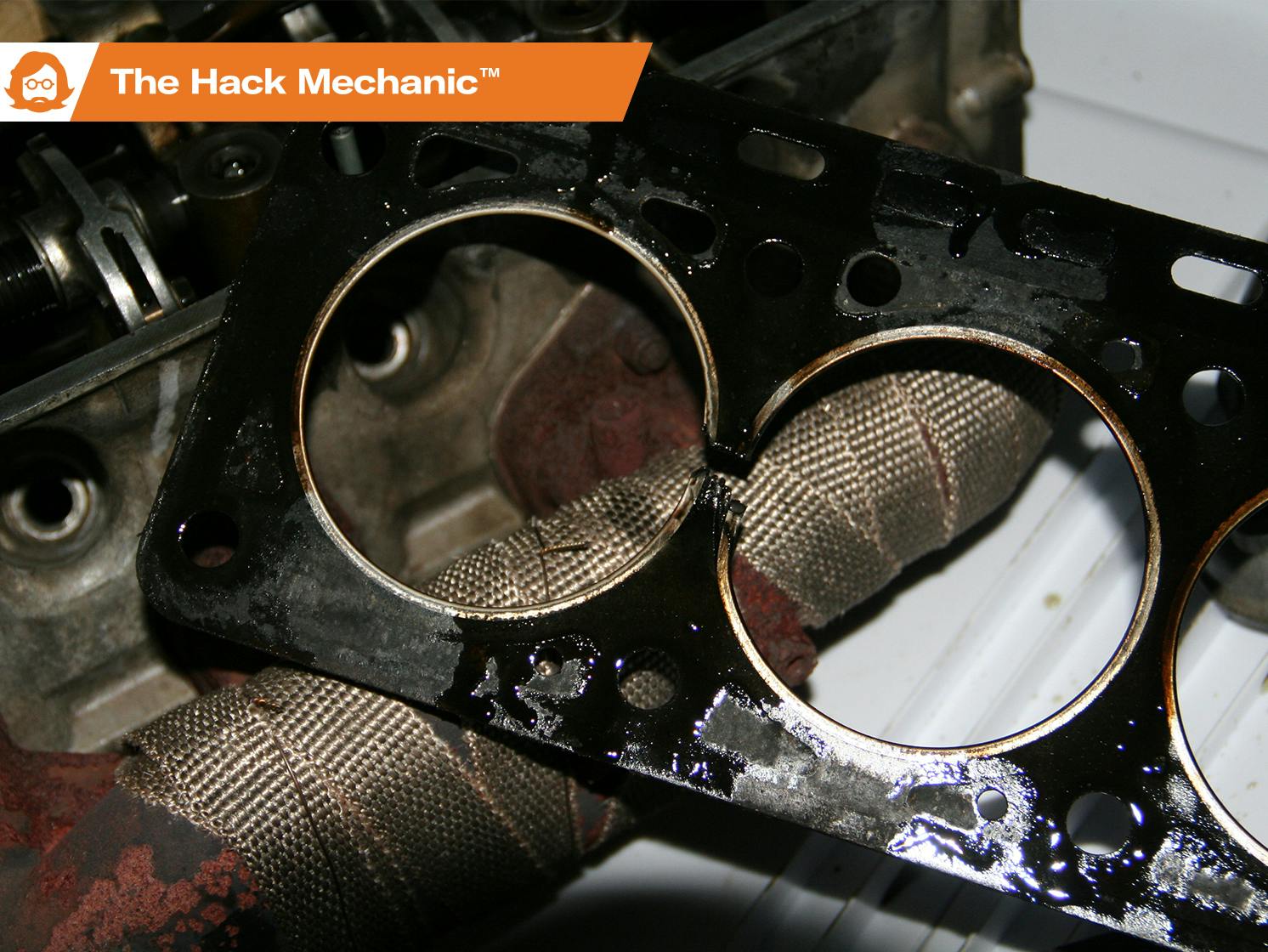
Today we’re going to talk about the closely related subjects of cracked heads and blown head gaskets. They’re not as common as what I often refer to as “The Big Seven” things likely to strand a vintage car on a road trip (ignition, fuel delivery, cooling, charging, belts, clutch hydraulics, ball joints). But if you own your old car long enough, or drive it hard enough, or buy enough basket-case cars that were parked because something expensive happened to the engine, odds are that eventually you’ll have to deal with one or both of them.
Nearly every reciprocating piston-in-block internal combustion engine has a head gasket sandwiched between the head and the block to seal things up. In addition to the holes for the head bolts to pass through, the head gasket has three types of passages in it. The largest are the big circular holes that provide the compression seal between the cylinders/pistons in the block and the combustion chambers in the head. These usually have metal rings around them to help contain the compression. The rest of the smaller passages, which can be circular or irregularly shaped, are either to allow coolant to flow from the block up into the head, or to allow oil into the head and then to drain back down into the crankcase. Head gaskets used to be made from asbestos or a fiber-like composite and coated with a wax-like finish, but modern head gaskets are usually multi-layer steel with a Viton coating. Sometimes there are silicone sealing beads around the water and oil passages.
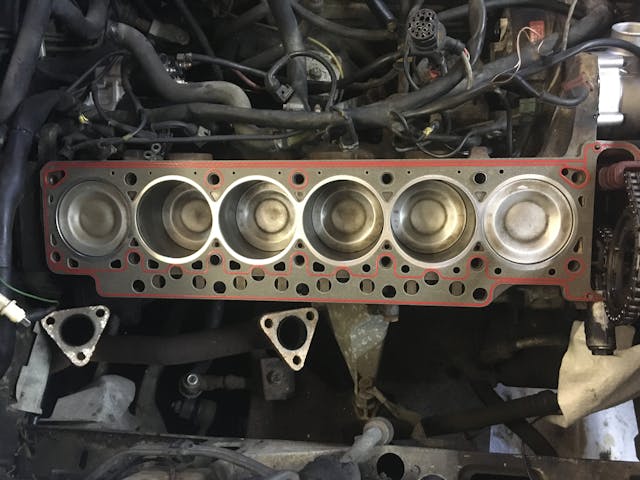
So long as the head gasket is intact, the head isn’t cracked, and the head bolts are correctly torqued, the three essential elements of compression, coolant, and oil should stay separated. But if the head cracks, or the head gasket deteriorates slowly or “blows” suddenly, the three can intermix with each other or escape to the outside world. That is, you can get compression, coolant, or oil leaking from the engine, or you can find coolant in the oil, or oil in the coolant, or compression (exhaust gases) in the coolant.
The principal cause of head cracking/warping is overheating (e.g., driving the car with the temperature gauge in the red), but heads can also crack due to age, vibration, or poor design. Similarly, overheating can also cause the head gasket to fail, either spewing coolant to the outside, or causing coolant and oil to intermix, or both.
Because the head gasket and the head are in such intimate contact, it’s sometimes difficult to tell a blown head gasket from a cracked head. And since the necessary repair action for both is the same—removing the head and inspecting both it and the gasket—a definitive diagnosis often doesn’t really matter in terms of the action you’ll need to take; you won’t really know until you get it apart. Still, here’s how I like to think about it and explain it:
Marketplace
Buy and sell classics with confidence
To me, head gasket and head problems fall into four main categories—those where there’s a sudden onset of poor running, those where the car runs fine but you find the “chocolate milkshake,” those that may be almost asymptomatic, and those where you know the engine was badly overheated.
If you’re driving the car, it’s not overheating, and it suddenly begins running horribly, making a racket, and sounding and feeling like it’s lost compression in one or more cylinders—but there’s not a rod through the side of the block and it doesn’t sound like a piston is chewing up a valve—it probably has “blown” the compression seal between two adjacent cylinders. This is usually verifiable by doing a compression test. You’re likely to find low or zero compression in the two adjacent cylinders due to the fact that at least one valve in one cylinder is open during some part of the tested cylinder’s compression stroke, and the tested cylinder sees that, due to the break in the head gasket’s seal between the cylinders. And if you pull off the head, the odds are strong that you’ll find this:
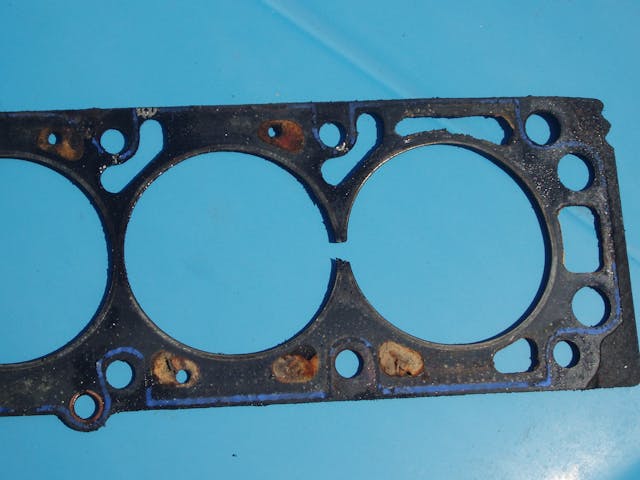
In the past, I’ve tended to associate “blown” head gaskets with lead-footed driving of cars not designed for it (e.g., treating your mother’s Chevette like it’s a Porsche—oh wait, maybe that was just me). But sometimes it’s just age. Or age coupled with hot running that warps the head and weakens the gasket.
If, on the other hand, the car was basically running fine, but when you checked the antifreeze you found what looks like a chocolate milkshake, this means there’s oil in the coolant (in fact, if it looks like a milkshake, there’s a lot of oil in the coolant), and the most likely cause is from the head gasket being blown—though “worn through” is a much more accurate description—between the coolant and oil passages. Though it’s also possible that the cause is a large crack between these passages in the head.
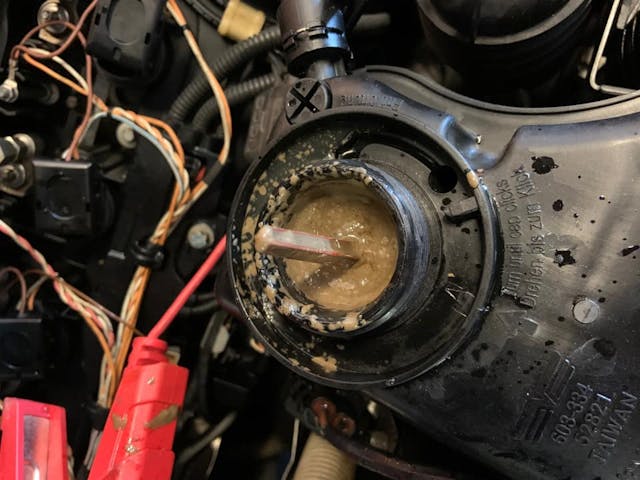
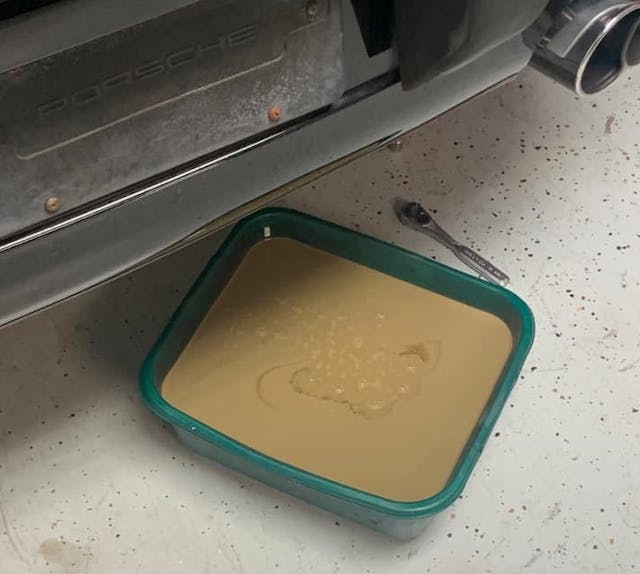
If there’s oil in the coolant, the odds are good that there’s coolant in the oil. Obviously, coolant is designed to transfer heat, and oil is designed to reduce friction, and the contamination of either with either prevents it from doing its task and is thus waaaaaaaay not a good thing, so even if the engine still seems to be running OK, it needs to be repaired ASAP.
A very small crack in the head can cause asymptomatic or lightly symptomatic issues. They can creep up on you in a number of ways. You may find that the car is using coolant, but you never see any leaking underneath. Or you may notice that there’s white sweet-smelling exhaust coming out the tailpipe. This is almost always due to coolant getting into the combustion chamber through a crack in the head. It may abate as the car warms up, the metal expands, and the crack swells shut. I only discovered the cracked head on a 1974 BMW 2002tii I had when I was readying the car for sale and did a compression test. The no. 3 cylinder showed slightly low compression, 120 psi as compared with 160 for the other cylinders. I conducted a leak-down test for that cylinder (setting the piston to top-dead center and pressurizing the cylinder through the spark plug hole) and saw bubbles in the radiator. It’s not uncommon for these heads to develop fine cracks in the small area between the intake and exhaust valves, but when I pulled the head, I didn’t see anything, so I took it to a machine shop for a valve job. When the machinist disassembled the head and hot-tanked it, the crack could be seen. Used 2002 heads are common and reasonably priced, so I replaced it. On a rarer more expensive head, you’d have it welded and pressure checked.
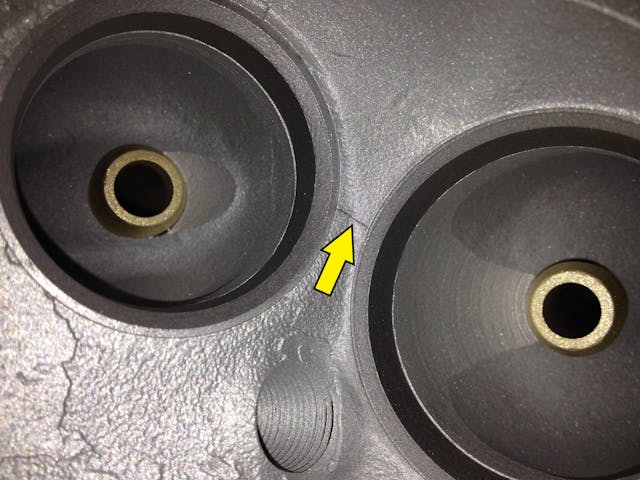
If you can’t find a suspected head crack with a leak-down test and don’t see bubbles in the radiator, you can try one of the products that chemically detect exhaust CO2 in the coolant. A kit like this has a chamber that you fill with detection fluid and a conical rubber seal that you hold in place over the radiator fill port while the engine’s running and watch to see if the detection fluid changes color.
There is another failure mode, though it’s not nearly as common as those above: It is possible for exhaust gases to escape into the coolant through the head gasket and cause the car to run hot. Elimination of other causes of hot-running, careful compression and leak-down tests, detection of exhaust in the coolant, and having the stones to pull the head and inspect the head gasket even when there’s no fluid mixing are required for diagnosis and repair.
Even if you pinpoint which of these failure modes you have, the level of risk to the rest of the engine varies. That is, if it’s your lightly driven vintage car, and you start to see a little oil in the coolant but no coolant in the oil, the odds that the components in the block have been damaged are slim. But if you or a family member drove a hot-running car until it suffered a catastrophic overheating event (e.g., was driven in the red until it puked coolant and oil and the car died), and after that, you found the engine and oil pan full of emulsified brown goo, the possibility that the bearings, pistons, and cylinder walls may have been damaged due to inadequate lubrication is very real.

Back when simple pre-1975 carbureted cars with minimal emission controls were ubiquitous, I used to love finding cars that were being sold cheaply because they had a blown or leaking head gasket. On an old car, it’s usually only a couple of hours of work to disconnect the headpipe from the exhaust manifold, undo the linkage and fuel connections to the carb, pull the distributor, drain the coolant, yank the hoses, remove the valve cover and upper timing cover, undo the timing gear, remove the head bolts, and lift the head off with the intake and exhaust manifolds attached. If you put a straight-edge on the head, determined it wasn’t warped, didn’t see any cracks in it, and the head surface was corrosion-free, you could simply clean everything up, spend the thirty or so bucks on a head gasket and maybe the related timing cover gasket, drop the head back on, flush the oil snot out of the cooling system, make sure all the contaminated oil was drained, and Bob’s your uncle. I bought and sold several 2002s and my Alfa Spider this way.
However, with newer cars—first the fuel-injected cars that supplanted carbureted ones in the early 1980s, then OBD-II in 1996—head removal and reinstallation is more involved due to all the added plumbing, electrical connections, and engine management functions such as electronic throttle bodies, sophisticated crankcase ventilation systems, and variable valve timing. The head gasket and surfaces themselves are still quite similar, but the amount of work necessary to get the head removed and reinstalled makes it so that you think twice about simply dropping the head back on with a new gasket. Instead, you want to be dead-certain that the head is uncracked, straight, and doesn’t need a valve job.
Even on a simple old car, these days I’m circumspect about replacing the head gasket and simply dropping the head back on without freshening it. If I look at the valve train and see a thick coating of black varnish, the odds are that the head hasn’t been off the car for decades, if ever, and so even if the head is straight, the rubber seals on the valve guides are probably old and brittle. And you’re going to change the seals, you’d be silly not to lap the valves. And once I’m at the doorstep of that task, I’d just as soon pay the three hundred bucks to take the head to the machine shop for them to hot-tank it, crack-check it, make sure it’s straight, shave it if it’s not, and give it a real valve job.
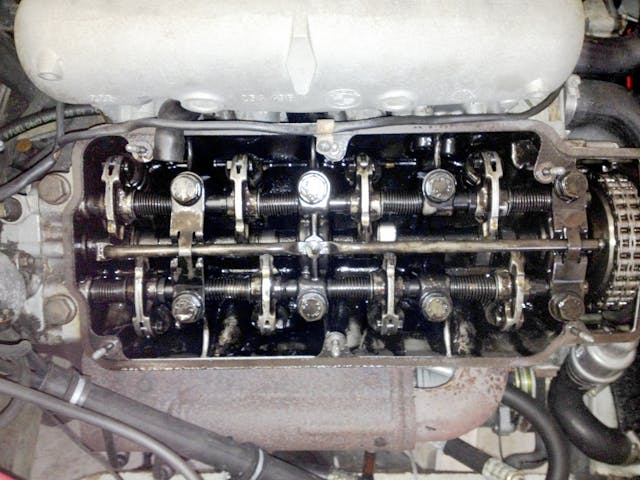
And that brings us full circle to the question of the likelihood of a head gasket failure while traveling and the feasibility of repairing it on the road. If you follow Sam Smith’s Weissrat Chronicles, you’ve read about how the head gasket in our friend Paul Wegweiser’s BMW 2002 blew between two cylinders while en route from Pennsylvania to Chicago, how Paul rented a U-Haul to get the car where it needed to go, and how our friend Ben opened up his shop on a Saturday to deck the head when it failed the straightedge test.
The funny thing is that Paul and Ben had been through this once before. It was in 2012 at an event in Winston-Salem, North Carolina. On the way back from dinner, Paul’s 2002tii began making an unholy racket. A test in the parking lot revealed no compression in cylinder nos. 3 and 4. They figured it was the head gasket and began pulling the head, even though no replacement gasket had been procured. A crowd gathered. Yours truly was the nurse handing tools and paper towels. The head gasket was removed and was indeed blown between 3 and 4. A head gasket set was magically crowd-sourced out of thin air. The end-to-end elapsed time from the beginning of the repair until the car was refilled with coolant and restarted was one hour, 56 minutes. Cheers erupted. It was more than just a hotel parking lot repair; it was a piece of head gasket-related performance art.
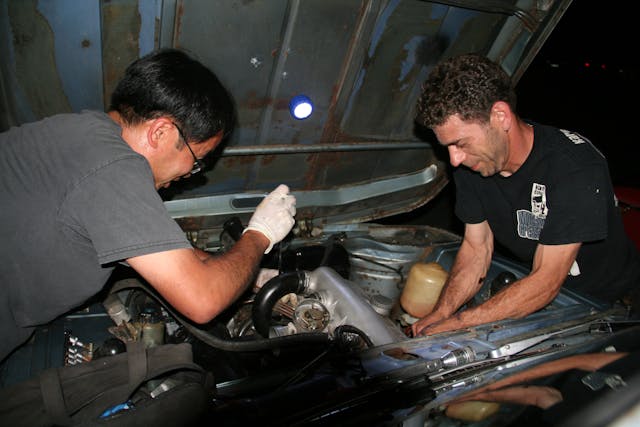
However, this got me thinking—obsessing, really—about whether “The Big Seven” should be “The Big Eight,” and whether a head gasket replacement should be part of a car’s prophylactic maintenance prior to a long road trip if the age of the head gasket is unknown. Shortly afterward, I had another event scheduled, this one included a 3000-mile round trip. I looked at my own BMW 2002tii (whose black varnish-laden valve train is shown above), imagined a head gasket failure in the middle of nowhere, decided that my peace of mind was worth the preemptive strike, and had at it.
The problem with that approach is that you should never pull the head off an engine unless you’re prepared to deal with whatever you find. So, in addition to replacing the head gasket (which showed its age but didn’t appear dangerously eroded) and doing a full head rebuild, when I saw light score marks on the cylinder walls, I wound up going into the block, honing and re-ringing, and replacing the rod bearings. The in-place engine refresh took a month. I barely got the car ready for the drive. And none of it was strictly necessary.
Even though my lead-footed friend Paul has blown not one but two head gaskets during road trips, I’ve re-thought certain parameters regarding roadside repairs. I used to, for example, travel solo and take not only a spare water pump but also two gallons of antifreeze and a drain pan, figuring what good is the water pump if you don’t have everything you need to replace it if it fails. Now, I’m far more likely to caravan with other people, and realize that, even if I find myself alone, I could take advantage of a cell phone and an Uber ride to pick up common items like antifreeze. I realize that the root issue is that my lifelong Yankee flintiness and self-reliance cause me to absolutely loathe the idea of being put in a situation where, if a head gasket goes, I have no choice but to pay a shop two grand for a repair that I could knock out with a $70 gasket set, but I try to remember that, in a world of social media, shared contacts, and pay-it-forward favors, there often are other options somewhere between a parking lot fix and an all-the-money repair bill.
I have other vintage cars running on head gaskets of unknown age, but I have not prophylactically replaced any of them. Instead, I monitor them for any signs of oil in the coolant, and if I have a road trip scheduled, I do a compression test to see if there’s an asymptomatic crack. Maybe this spring I’ll buy a CO2 coolant tester just to up the confidence level.
And I do take a head gasket set with me on road trips. I certainly can’t replace one in less than two hours, but if nothing else, having it in the car wards off bad juju.
***
Rob Siegel has been writing a column (The Hack Mechanic™) for BMW CCA Roundel magazine for 34 years and is the author of seven automotive books. His new book, The Lotus Chronicles: One man’s sordid tale of passion and madness resurrecting a 40-year-dead Lotus Europa Twin Cam Special, is now available on Amazon (as are his other books), or you can order personally-inscribed copies from Rob’s website, robsiegel.com.






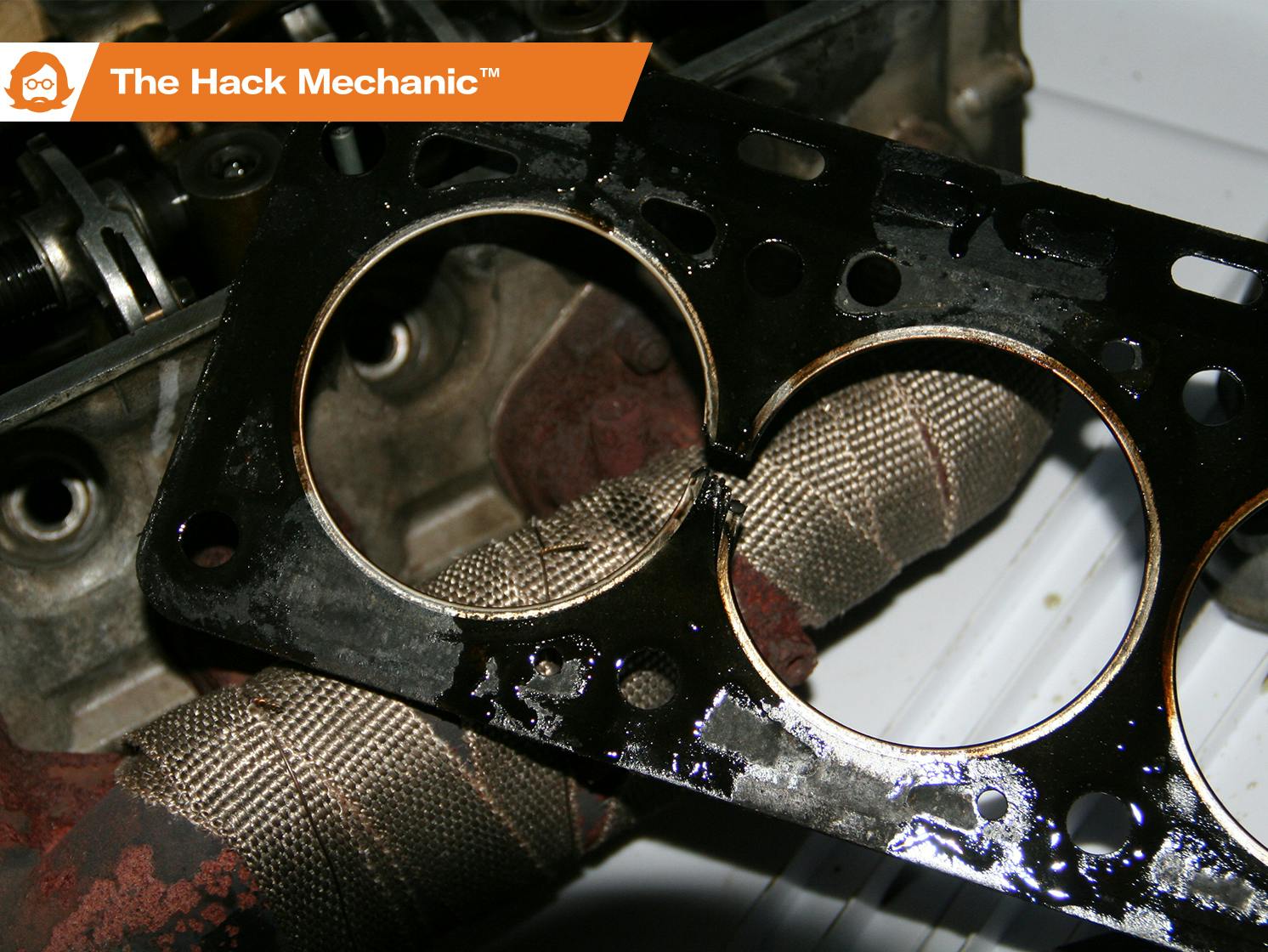
That was a GREAT article, and in some parts funny too! Thank you for your post. I learned Alot from it.
May I ask you Sir, How do I tell which cylinder, of a 5 cylinder diesel will be the one which is leaking gases into the cooliong system?
We have an old Mercedes Benz MB140D and its uses a small amount of water but the main problem, is that at times, it hydraulics and wont turn over. Starter engauges but cant turn the cold engine. Other days, alls fine and it starts immediately
Anyway, I would like to try K-Seal Head gasket Repair and need to remove the injector of the troublesome combustion cyl’ so as not to blow the product away from where it needs to be.
Trouble is, how do I tell which cylinder is the faulty one.
Because the van is built over the engine, there is limited access to the front 2 or 3 cylinders so it will end up being yet again, a case of going to hell rather than to heaven ’cause I m sure there will be bad words muttered….. OUT LOUD!.
ANY ideas and a way to determine which cyl in needing to be ‘un-plugged,’ would be greatly appreciated.
Best wishes to thee, she and yours during these changing times.
Kind regards,
Will
Darfield ,Canterbury, NZ.
Osram to come across many mechanic giving wrong advice on cracked head gasket blown only for the use to bump into motor replacement only because lack of the knowledge to do the job it’s not to hard to do head gasket I’ve done all types
Reply.Comment.
Read Comments On Issue.